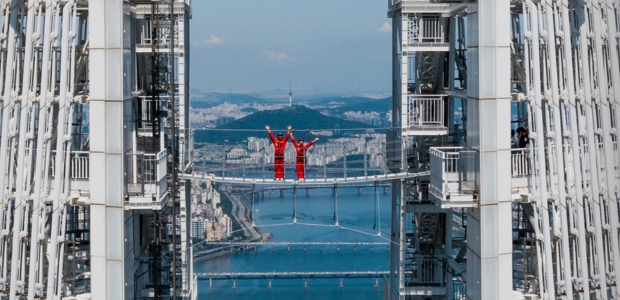First
Impressions: Seoul
Seoul
is huge and spread out, but getting around is super easy thanks to the subway
system. InsideAsia provides a Korea Transportation Card preloaded with a small
amount—you can easily top it up at machines in the stations.
We
stayed three nights at the G3 Hotel in the Chungmuro area,
conveniently right next to the subway. A great base to explore the city! Just a
heads-up—rooms in South Korea tend to be on the smaller side.
Exploring
Seoul on Foot
We
did an 11km walk to Gyeongbokgung Palace and along the beautiful Cheonggyecheon
Stream, which starts in a lively public space. On weekends, you’ll often
find events and a public library where people relax by the stream. It’s
peaceful and perfect for both locals and visitors.
Nearby
is Ikseon-dong, a quirky neighbourhood full of cool little lanes, shops,
jewellery stalls, cafes, bars, and—of course—the famous Salt Bread. We
joined the queue at Soha Salt Pond, and it was worth it!
History,
Hanoks & Korean Food
South
Koreans are incredibly proud of their history. It’s worth reading up on the Joseon
Dynasty before your visit—it helps bring everything to life.
We
visited Bukchon Hanok Village, which, while touristy, still has hundreds
of traditional homes called Hanoks. It's bustling with food stalls,
craft shops, and hands-on experiences like making traditional “Hopae”
(an old form of ID from the Joseon era).
That
evening, we joined a walking food tour that included a Korean BBQ and Chimaek
(Chicken & Beer). Come hungry—there’s so much food! If your clients
have allergies or dietary needs, be sure to let the tour organisers know—they
can adjust the experience and recommend specialised restaurants.
Nature
& Temples
Next,
we headed to Bukhansan National Park—an incredible spot for hiking and
autumn views. While we didn’t hike, we visited the peaceful Jingwansa Temple,
which is home to around 30 female monks.
Interesting
fact: During Japanese rule (1910–1945), Koreans weren’t allowed to display
national pride. A hidden Korean flag was later discovered in this temple in
2009—a powerful piece of history.
We
also wandered through a nearby Hanok village—another great chance to enjoy the
autumn colours.
Jeonju:
Food & Tradition
After
Seoul, we took a 2-hour train to Jeonju. Note: there are two large steps
up onto the trains, so pack accordingly.
On
arrival, we jumped into a Bibimbap-making experience, then changed into
traditional Hanboks and explored the town. It’s very touristy, with
small streets, quirky shops, and carnival-style games. At night, the area
sparkles with lights and buzzing markets.
Our
hotel, Lahan, offered beautiful views.
Gyeongju:
Stepping Back in Time
A
3-hour minibus ride took us to Gyeongju, the ancient capital of the Silla
Kingdom. It's a charming, historical town filled with cultural treasures.
We
stayed in a traditional Hanok-style hotel (Hwangnamgwan). It came with a
western “wet” bathroom, and we slept on floor mattresses with flat pillows—a
padded jacket makes a handy extra cushion! Rooms included tea and coffee and
were very comfortable.
Busan
& Gamcheon Cultural Village
On
the way to Busan, we stopped at the colourful Gamcheon Cultural
Village. Originally a shanty town, it was transformed by local artists into
a vibrant area full of art shops, cafes, and murals. It’s quite hilly but very
photogenic.
In
Busan, we stayed at L7 Haeundae—a great beachside hotel with a rooftop pool
and amazing views. Just note: during peak season (June–August), there may be an
extra fee to use the pool.
The
Haeundae area is lively, with shops, night markets, bars, and cafes. At
night, the vibe is fantastic.
Scenic
Temples & the Journey Back
We
visited the Haedong Yonggungsa Temple, just 30 minutes from Busan. It’s
perched on a cliff, overlooking the sea—one of the most spectacular temples in
South Korea.
Then,
we took a 2hr 40min train ride back to Seoul. It can take up to an hour to
reach the station from your hotel. Trains are clean, efficient, and easy to
use. No need to show your ticket—just find your reserved seat. Luggage storage
is at the front of the carriage, or behind the last row.
Final
Stops: Seongsu & Sky-High Views
Back
in Seoul, we explored Seongsu District, often called the Brooklyn of
Seoul. Think converted factories, rooftop bars, pop-up shops, local
galleries, and loads of trendy cafes. You could easily spend hours here.
To
top it all off, we visited the Lotte World Tower and did the Sky
Bridge Walk—555 metres high on the 125th floor. Not for the faint-hearted,
but the views are unreal!
I really enjoyed my South Korea itinerary, this trip offered the perfect mix of
history, culture, food, nature, and modern urban life—with a few surprises
along the way. If you would like me to assist in planningy our travel to South Korea please contact me at darienne@haatravel.com.au

Photo credit @SeoulSky